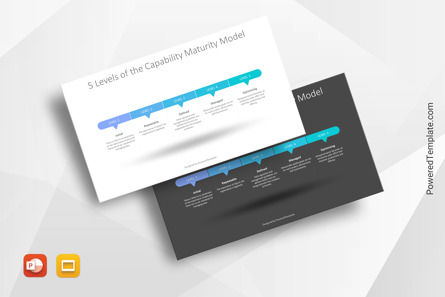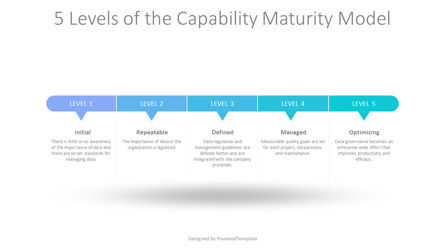99754
5 Levels of the Capability Maturity Model - Free Google Slides theme and PowerPoint template
ID: 10842
Free for personal and commercial use with attribution required.
How to attribute the author?Unlock this file and gain access to other Premium resources.
Go Premium and Download! | Already Premium? Sign in
Free Google Slides theme and PowerPoint template
Developed and published by the SEI (Software Engineering Institute) at Carnegie Mellon University, the Capability Maturity Model (CMM) consists of 5 incremental levels of performance. This free presentation template is designed to help you accurately represent them visually. The simple PowerPoint or Google Slides template uses a single horizontal line to mark each of the 5 stages, along with text placeholders for introducing relevant information about this quality management system. It’s an easy way to help your audiences better understand the concept and its many applications in multiple industries. Download it now to start using it right away!The Capability Maturity Model (CMM) is an important framework used by many companies to evaluate and plan their process improvement initiatives. It outlines 5 distinct levels of maturity that a company can pursue during the course of its process development. The lowest level, Level 1, is referred to as Initial, where process improvement activities are ad hoc and reactive in nature. Level 2 is known as Repeatable and emphasizes the institutionalization of processes to improve consistency and repeatability. Level 3, Defined, moves organizations further by creating unified sets of standards and procedures that define certain aspects of the software development process. Level 4, Managed, focuses on establishing quantitative objectives for the software development process; these objectives enable standardized measurement of the defined processes. Lastly, Level 5 is termed Optimizing; at this level, processes become continuously refined to reach ever-higher levels of quality. Reaching each milestone outlined within each level allows organizations to move through the stages toward fully optimized processes – resulting in higher quality products released in faster cycles with reduced costs.
Template Features:
- - 100% editable and easy to modify
- - 2 dark and light slides to impress your audience
- - Contains easy-to-edit graphics
- - Designed to be used in Google Slides and Microsoft PowerPoint
- - PPT/PPTX format file
- - 16:9 widescreen format suitable for all types of screens
- - Includes information about fonts, colors, and credits of the free resources used.
Related Items






